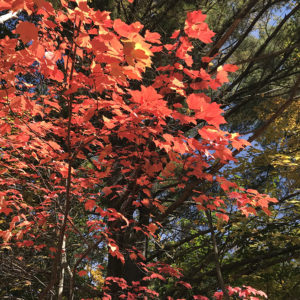We have been, since Halloween, in the midst of a span of time known as Hollantide. It is a time when we traditionally remember our dead. All Hallows (All Saints Day) is what gives the span its name––Hollantide being but a corruption of the word Hallowtide. All Hallows is what names the season and what names Halloween, of course: All Hallow’s Eve. Halloween ushers in All Saints Day which ushers in All Souls Day, which brings us the surreal beauty of Dia de Los Muertos, Day of the Dead. These are the days known in Italy simply as I Morti: The Dead. This is Hollantide at its core: the time of the sacred, the time of the holy, days of remembrance that continue through to Martinmas, which comes on Sunday, the 11th of November.
St. Martin of Tours, who we celebrate on Martinmas, was a Roman military veteran (and we’ll talk of veterans later, for his day also brings Veterans Day) in the fourth century who opted to take up Christian pacifism and is known best for helping a poor, drunken man on a cold winter’s day by tearing his own cloak in two so that the poor fellow could have something to keep him warm. St. Martin has since become a patron saint of tailors, vineyard keepers, winemakers, and drinkers.
What makes Martinmas the bookend to Halloween? The connection may have something to do with the Celtic New Year––Samhain––which, over the centuries, evolved into our Halloween. Samhain marks, as well, in traditional reckoning of time, the transition to winter. With all of these November days since Samhain, since Halloween, our thoughts have gone deeper below the earth, just as the natural world also shifts its energy below the earth. Winter leads us there. Persephone leads us there. The trees take us there: The leaves have flown, all growth now is below, in the roots. This makes for stronger growth above ground come spring and summer: balance. As above, so below. Oh and guess what? November 11 is the old style date of Samhain. And here we are, then, at Martinmas.
It is, as well, Veteran’s Day, when we honor in the United States all who have served in the military. We used to call it Armistice Day, for it originally marked the signing of the armistice that ended the Great War, which is what we used to call World War I before World War II came to be. The armistice that brought peace after years of senseless fighting was signed in 1918 on Martinmas, at the eleventh hour of the eleventh day of the eleventh month––100 years ago this Sunday, in fact.
So much associated with this day. One more thing: Martinmas is, traditionally, the time to taste the new wine, a fact certainly related to St. Martin’s patronage of winemakers and vineyard keepers. Each year’s Beaujolais Nouveau wines of France, always young wines, are typically released on or around Martinmas, and the day is often accompanied by a good meal featuring roast goose or turkey and chestnuts––typical harvest celebration foods––and, in Italy, Biscotti di San Martino: biscotti that are so hard, the only way to eat them, really, is to first dunk them in wine. My grandparents, all of them immigrants to the US from Italy, all made wine. My father was glad to get married and leave the winemaking that went on in his family home behind… but he married my mother, and her family made wine each autumn, too. The barrels that had to be cleaned out with water and chains, the crates of Zinfandel grapes that had to be washed and crushed… it was hard work, and I wish I could have been part of it. Winemaking is knowledge that has passed by the wayside in my family, drifted away. But certainly San Martino was important to all of my grandparents and to their wine. Grandpa made the wine, but Grandma made the cutte from the same must, the same grape juice, boiled down on the kitchen stove, reduced to a thick syrup, so specific to Lucera, her small Italian city, used in desserts specific, too, to autumn and winter, some of which are full of meaning, too, as we remember those who have passed. Like cicce cutte, a penitential dessert eaten during these Hollantide days and known practically no where else but Lucera: cooked wheat berries with chocolate, chopped almonds, pomegranate, and spices like cloves and cinnamon, and poured over the concoction? That same syrup made during the winemaking. The pomegranate certainly a direct connexion to the story of Persephone, who must go beneath the earth for the winter.
In all the hustle and hubbub of Halloween and Dia de Muertos, it took a while to get to making your Convivio Book of Days Calendar for November… but it’s here now! Our monthly gift to you is a printable PDF; this month’s edition is available right here.
COME SEE US!
Harvest Makers Marketplace
Sunday November 11 from 10 AM to 4 PM
Florida Atlantic University
Boca Raton
We’ll be transitioning toward Christmas with a pop-up shop of traditional German advent calendars and advent candles from England, plus handmade Christmas ornaments and decorations from Germany and Mexico and our full line of Shaker herbs & teas and more. Plus there’s live music all day: Rio Peterson from 10 AM to 1 PM, Ella Herrera from 1 to 4 PM. It’s going to be a good one!
